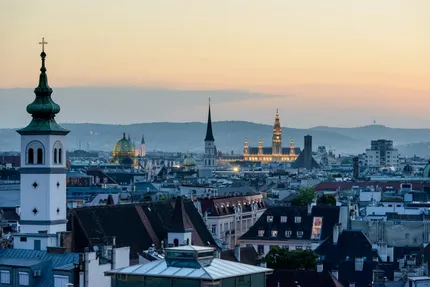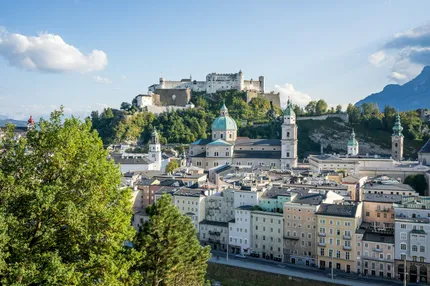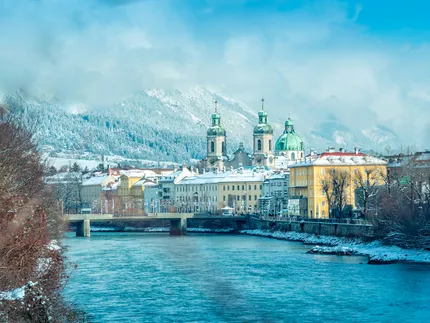CityTouring
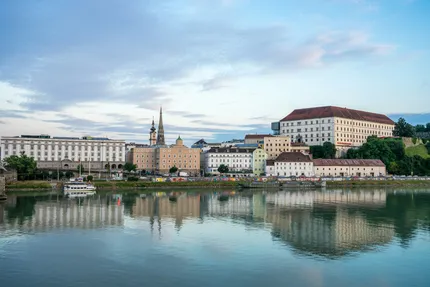
City trip to Linz
AustriaLinz, capital of Upper Austria, sits on a broad bend of the Danube and has reinvented itself from steel city to a forward‑looking hub of culture and technology. Its walkable old town centres on the vast Hauptplatz with the Baroque Trinity Column, leading to the soaring New Cathedral and the hilltop Schlossmuseum with views of the river. On the waterfront, the glassy Lentos Kunstmuseum shows modern and contemporary art, while the Ars Electronica Center across the Danube invites hands‑on exploration of robotics, AI, and media art. Green riverside lawns at the Donaulände make easy picnic spots, and cafés serve the city’s namesake Linzer Torte.
Ride the historic Pöstlingbergbahn tram up to the basilica for panorama and the nostalgic Grottenbahn attraction for children. Industrial heritage is present but accessible, from portside Mural Harbor’s large‑scale street art to voestalpine Stahlwelt’s sleek visitor center. Compact, efficient trams and plentiful bike lanes make getting around simple, and the Danube Cycle Path passes right through, linking museums, markets, and relaxed beer gardens in a single, low‑stress loop.
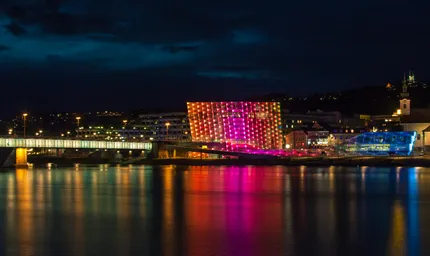
Ars Electronica Center
Interactive museum of digital culture and future technologies on the Danube. Explore media art, robotics, AI, and bio labs through hands-on exhibits and demonstrations. The Deep Space 8K theater offers immersive visuals and data visualizations. Its glass facade becomes a luminous landmark at night. Frequent temporary exhibitions and workshops suit curious visitors.
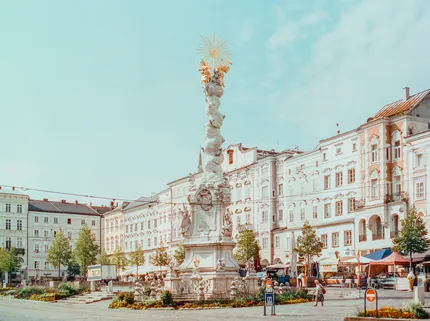
Hauptplatz & Old Town
Start at the expansive Hauptplatz, framed by historic facades and the Baroque Trinity Column. Wander narrow lanes toward the Landhaus with Renaissance arcades and the Alter Dom, where Bruckner once played. Cafés, boutiques, and weekly markets animate the area. It’s the tram hub and a convenient, atmospheric orientation point for newcomers.
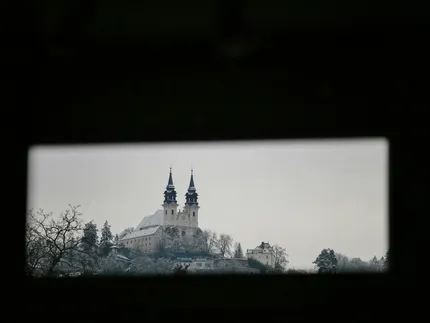
Pöstlingberg & Pöstlingbergbahn
Ride the historic Pöstlingbergbahn from Hauptplatz up Linz’s landmark hill for sweeping views over the city and Danube. Visit the pilgrimage basilica, walk the panoramas, and, with kids, enjoy the nostalgic Grottenbahn. Sunset is rewarding, and cafés and a beer garden invite breaks. It’s a classic, easy escape. Return on foot via forest trails if you prefer.
Linz is a strong fit for travelers who value culture you can actively engage with. Media‑arts and tech enthusiasts will get the most from the Ars Electronica Center’s interactive labs and the annual Ars Electronica Festival. Contemporary‑art fans should plan time for Lentos and the street‑scale canvases of Mural Harbor, best seen on a guided boat tour of the port. Classical‑music lovers can anchor an evening at the Brucknerhaus, or seek out organ recitals linked to Anton Bruckner’s legacy. Families with school‑age kids will find easy wins: the Grottenbahn and zoo on Pöstlingberg, boat trips on the Danube, and play spaces along the Donaulände. Cyclists and runners can base in the center and ride car‑light stretches of the Danube Cycle Path toward Ottensheim or Mauthausen, with plenty of cafés for stops.
Those curious about industry will appreciate voestalpine Stahlwelt’s polished exhibits and prebookable works tours. Food‑minded city trippers can sample Linzer Torte, visit the Südbahnhofmarkt for regional produce, and try relaxed Wirtshaus classics near the Hauptplatz. If you prefer compact, low‑stress weekends with reliable public transport rather than nightlife‑heavy marathons, Linz delivers: distances are short, trams are frequent, and most sights cluster along the river, making a two‑day stay feel complete without rushing. Design‑minded visitors can trace contrasts from Baroque fronts on Landstraße to the clean lines of Lentos, AEC, and the Brucknerhaus along the river. Solo and budget travelers benefit from safe streets and plentiful midrange stays.
Three top reasons for a city trip to Linz
- Explore Linz's pioneering media arts: Ars Electronica Center's interactive exhibits, Deep Space 8K, Lentos Art Museum's riverfront design, and Ars Electronica Festival transforming the city into a laboratory of creativity.
- Admire Danube riverfront vistas from Pöstlingberg: ride the historic mountain tram, visit the basilica and Grottenbahn, then stroll or cycle the Donauradweg past beaches, murals, and bridges framing sunset-lit Linz.
- Experience Linz's layered history: baroque Hauptplatz and Old Town courtyards, soaring New Cathedral (Mariendom), innovative voestalpine Stahlwelt steel museum, and cafes serving original Linzer Torte alongside contemporary Upper Austrian cuisine.
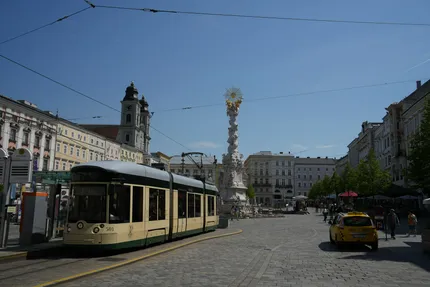
Best time to visit Linz
The most pleasant months are May, June, and September, when daytime highs sit around 20–25°C, rainfall is moderate, and you can enjoy riverside parks and open‑air concerts without the crowds of peak summer. Early September adds the Ars Electronica Festival and the Linz Klangwolke, a large outdoor sound-and-light event along the Danube, while late September spills into the Bruckner Festival. July and August are warmest and liveliest on the quays and at nearby swimming lakes, but occasional heat waves and storms are possible. December is atmospheric for Christmas markets on Hauptplatz and in the Volksgarten, though days are short and chilly.
More activities and things to see in Linz:
Lentos Kunstmuseum
Striking riverside museum for modern and contemporary art, recognizable by its glowing glass facade. Inside are strong Austrian and international collections, plus ambitious temporary shows and photography. The riverside lawn and small sculpture park invite pauses between galleries. A café with terrace overlooks the Danube, making it pleasant year-round in any weather.
St. Mary’s Cathedral (Neuer Dom)
Austria’s largest church by capacity, this neo-Gothic cathedral impresses with soaring nave, intricate stonework, and rich stained glass, including the Linz Window showing city history. Climb the tower on selected days for city views. The crypt and side chapels offer quiet reflection. Occasional concerts highlight its resonant acoustics. Guided tours provide helpful context.
Donaulände Park & Danube Cruises
Relax along the Donaulände, a riverside park with sculptures, bike paths, and summer events. Locals picnic, jog, and attend open-air festivals. Riverboats run sightseeing cruises, giving perspectives on bridges, harbor areas, and skyline. Sunset light can be excellent for photos. Combine with a bike ride on the Danube cycle path.
Mural Harbor (Street Art at the Port)
Explore Linz’s harbor transformed into one of Europe’s largest open-air galleries. Massive murals by international artists cover warehouses and floodwalls. Join a guided boat or walking tour to learn about techniques, artists, and changing pieces. It’s photogenic, accessible from the center, and shows the city’s creative edge beyond museums today.
voestalpine Stahlwelt
Insightful visitor center and museum at Austria’s leading steel producer. Interactive exhibits explain materials, processes, and how steel shapes everyday life. On weekday plant tours, don safety gear and see blast furnaces, rolling mills, and logistics in action. Advance booking and ID are required. Architecture and views round out the visit.
Schlossmuseum Linz
Perched above the old town, the Schlossmuseum blends a historic fortress with a modern wing. Exhibitions span natural history, archaeology, folk culture, art, and technology from Upper Austria. Remnants of Roman walls are visible nearby. The terrace and windows provide broad city and river views, rewarding even quick visits too.
Brucknerhaus
Riverside concert hall renowned for warm acoustics and a focused program. Home to the annual Brucknerfest every autumn, it also hosts orchestral, chamber, jazz, and contemporary performances year-round. Architecture by Heikki and Kaija Siren emphasizes clarity and wood. Check schedules for tours or affordable tickets to experience the sound inside.
Tabakfabrik Linz
Monumental modernist industrial complex by Peter Behrens and Alexander Popp, now a creative campus. Explore exhibitions, design shops, and startups during open days and markets. Guided tours explain architecture, social history, and redevelopment. Events, concerts, and festivals activate the courtyards. It captures Linz’s industrial roots and contemporary innovation energy today.
Linz Botanical Garden
Tranquil gardens on a hillside with extensive outdoor beds and greenhouses. Highlights include alpine plants, cacti, orchids, and seasonal displays. Paths and benches invite slow exploration; signage is informative. A small café and views over the city add appeal. It’s an easy nature break within reach of the center too.
Getting around in Linz
Linz’s compact center is easily walkable, and the Danube embankments and inner districts are flat and bicycle-friendly. An extensive tram and bus network operated within the Upper Austria transport association (OÖVV) links the Hauptbahnhof, Old Town, universities, and suburbs at high frequency. Tickets are integrated and available from machines, on-board validators, and apps; day passes are good value for visitors. The historic hill tram to Pöstlingberg is included in the urban network. Night and weekend services run on core routes, but frequency drops late, so check timetables. Bike rental and e-scooters are widely available; the Danube Cycle Path offers safe corridors across town. Driving in the center is slower due to one-way streets and paid short‑stay zones; use park‑and‑ride lots near tram stops if you have a car. Taxis and ride-hailing cover late hours. For regional outings, frequent trains from Linz Hbf reach Wels, Steyr, and the Salzkammergut. Most attractions cluster along the river, reducing the need for a car.
Getting to Linz
Linz Airport (LNZ, Blue Danube) lies about 12 km southwest in Hörsching, with limited scheduled routes and seasonal charters; check timetables. For broad international access, fly into Vienna (VIE), Munich (MUC), or Salzburg (SZG), then continue by rail. From Vienna Airport, take an ÖBB Railjet or S-Bahn to Wien Hbf and connect to frequent Railjet/WESTbahn trains to Linz Hauptbahnhof (about 1 h 30–1 h 50 in total). From Munich, direct EC/ICE trains via Passau take roughly 3 h; from Salzburg, Railjet/WESTbahn takes about 1 h. Linz Hbf is a major stop on the Vienna–Salzburg corridor with direct long-distance services to Vienna, Salzburg, Innsbruck, Passau, and sometimes Frankfurt or Zürich. Long-distance buses (e.g., FlixBus) link Linz with Vienna, Prague, Munich, and other cities, usually stopping near the main station or central bus stands; book in advance for best fares. If driving, the A1 West Autobahn and A7 connect efficiently, but trains are usually faster and more convenient for cross-border travel.
